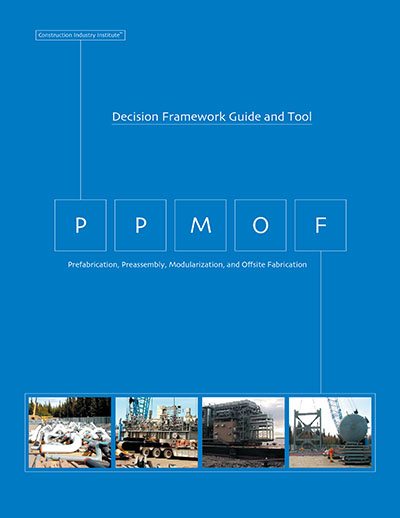
Prefabrication, Preassembly, Modularization, and Offsite Fabrication in Industrial Construction: A Framework for Decision-Making
Prefabrication, preassembly, modularization, and offsite fabrication (PPMOF) offer potential benefits that are more important than ever in today’s markets. Owners want better facilities faster, at the lowest possible cost, and always safer. For the right project conditions, PPMOF can help achieve the owners’ goals.
PPMOF also can help project teams meet the challenges of demanding schedules, adverse site conditions, and limited availability of skilled labor. Using these methods, however, requires careful consideration of their implications for engineering, transportation, coordination, and project organization.
Managers considering PPMOF need a systematic method to evaluate the potential benefits and barriers to using these special methods on their projects. CII formed the PPMOF Project Team to update and extend prior CII efforts and to help improve project performance through use of PPMOF. The project team chose to focus on identifying the requirements for effective use of PPMOF on industrial projects, and then developed a framework to use as a decision aid about possible use of these methods. The framework includes a decision-timing map, a flow chart, tools for strategic analysis, and suggestions for a more detailed tactical analysis.
The results described in this summary build on and extend prior CII work on this subject, based on industry drivers that strongly favor increased use of PPMOF. The purpose is to present the benefits of PPMOF and motivate decision makers and project teams to fully consider PPMOF using the decision framework. The successful CII Project Definition Rating Index (PDRI) tool for analysis of project readiness has improved project performance; the PPMOF analysis framework can bring similar benefits in evaluating possible use of these special methods.
The decision-making process and tool is intended to help recognize the issues to consider in making early decisions on modularization and later decisions on preassembly, prefabrication, and offsite construction. It aims at facilitating a systematic, thought-out process by providing a conceptual framework for decision-making. Although subjective in nature, the tool is designed to assist in making good, judgment-based decisions. (RS171-1, p. 18)
The Decision-Timing Map (Figure 6) and Decision-Making Flow Chart (Figure 7) were designed to identify recommended stages in the project life cycle for using the PPMOF tools.
{^widget|(containertitle)Figure+7.+Decision-Making+Flow+Chart|(name)WatermarkImage|(image)%7e%2fCII%2fmedia%2fPublications%2f171_1_figure7.JPG%3fext%3d.jpg|(widget_displayname)WatermarkImage|(width)|(height)^}
The decision framework can help identify the drivers and impediments to PPMOF that managers need to address in a project execution plan. These methods provide a spectrum of potential implementation choices rather than an “all or nothing” decision. The use of the decision framework should allow for variable timing of decision-making, consistent with pre-planning and the project life cycle. Conceptual framework for the Tactical Analysis of PPMOF alternatives is to provide a methodology to evaluate the cost impact of PPMOF strategies. It is for use during conceptual design and at the beginning of detailed design. (RS171-1, p. 25)
Tactical framework focuses on the cost-per-unit level of the project. In general, the conceptual framework for Tactical Analysis consists of a series of tasks for making cost comparisons. (RS171-1, p. 28)
Schedule and Labor Comparison – Provides an example of the difference in schedule between an all stick built project and modularization. In this example there was a savings on the front end and two on the back-end due to PPMOF. The example was based on relocating 40% of the hours offsite with PPMOF. Building consensus on cost benefits of the schedule reduction and relocation is a challenge to overcome. The owner, contractor, and engineering should share cost and financing data, adequate quantification of schedule cost benefits.


